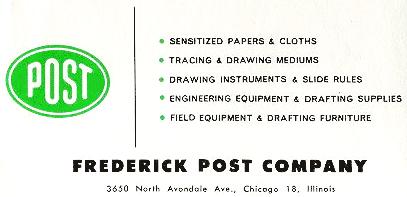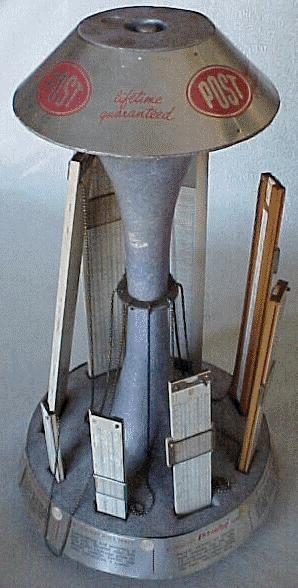 Post sold a wide variety of slide rules, both under its own name and under the names of various manufacturers. Post itself actually made no slide rules; even those rules that bore the Post brand name were manufactured by others. At one time or another Post brand slide rules were made by Dennert & Pape, Nestler, Faber, Hemmi, Lawrence Engineering Service, Charvoz-Roos, Bruning and Gilson. Post also sold branded slide rules from Richardson, Vicari, Boucher, Sexton, Halden, Chandler, Ritow and Winslow.
Post sold a wide variety of slide rules, both under its own name and under the names of various manufacturers. Post itself actually made no slide rules; even those rules that bore the Post brand name were manufactured by others. At one time or another Post brand slide rules were made by Dennert & Pape, Nestler, Faber, Hemmi, Lawrence Engineering Service, Charvoz-Roos, Bruning and Gilson. Post also sold branded slide rules from Richardson, Vicari, Boucher, Sexton, Halden, Chandler, Ritow and Winslow.
 Until about 1932, Post slide rules were made by a variety of German manufacturers. There was little consistency in catalog numbers until the mid 1920s when '1452' was assigned to the top-of-the-line 10-inch Mannheim rule. Even though suppliers changed several times, 1452 continued to designate the best 10-inch Mannheim rule (until Post discontinued all 10-inch Mannheim rules except student models in the 1960s).
Until about 1932, Post slide rules were made by a variety of German manufacturers. There was little consistency in catalog numbers until the mid 1920s when '1452' was assigned to the top-of-the-line 10-inch Mannheim rule. Even though suppliers changed several times, 1452 continued to designate the best 10-inch Mannheim rule (until Post discontinued all 10-inch Mannheim rules except student models in the 1960s).
 In 1932 Post began buying all of its straight slide rules from Hemmi Keisanjaku in Japan. Except during World War II, Hemmi remained Post's exclusive supplier of slide rules until slide rule sales ceased in the 1970s.
In 1932 Post began buying all of its straight slide rules from Hemmi Keisanjaku in Japan. Except during World War II, Hemmi remained Post's exclusive supplier of slide rules until slide rule sales ceased in the 1970s.
 After Post became Teledyne Post in 1970, slide rules were sold under both the Post and Teledyne Post names until 1972. In 1972, the Frederick Post brand name disappeared and the Teledyne Post '44' numbering system was introduced. Teledyne Post ceased selling slide rules in the mid 1970s.
After Post became Teledyne Post in 1970, slide rules were sold under both the Post and Teledyne Post names until 1972. In 1972, the Frederick Post brand name disappeared and the Teledyne Post '44' numbering system was introduced. Teledyne Post ceased selling slide rules in the mid 1970s.
 Dating Post Brand Slide Rules
Dating Post Brand Slide Rules
 Before 1932, Post brand slide rules were made by various German manufacturers. Samples of these rules are so rare that we have not been able to formulate any principles for dating them. However, if the rule is accompanied by a case or literature, it may be possible to date it from the style of the Post logo.
Before 1932, Post brand slide rules were made by various German manufacturers. Samples of these rules are so rare that we have not been able to formulate any principles for dating them. However, if the rule is accompanied by a case or literature, it may be possible to date it from the style of the Post logo.  The figure at the left (click for an expanded, detailed view, use your browser BACK to return) shows how the Post logo was represented in various catalogs from 1910 to 1944.
The figure at the left (click for an expanded, detailed view, use your browser BACK to return) shows how the Post logo was represented in various catalogs from 1910 to 1944.
 Note that the words The Frederick Post Co., Chicago formed into an oval actually appeared only on the prewar Post 1461 Universal Deluxe Duplex slide rule but on no case or literature of which we are aware. The word 'POST' surrounded by an ellipse logo was adopted in 1944 and was retained until Post became Teledyne Post in 1970.
Note that the words The Frederick Post Co., Chicago formed into an oval actually appeared only on the prewar Post 1461 Universal Deluxe Duplex slide rule but on no case or literature of which we are aware. The word 'POST' surrounded by an ellipse logo was adopted in 1944 and was retained until Post became Teledyne Post in 1970.
 Post sold Hemmi slide rules exclusively from 1932 to 1941. Hemmi slide rules are easily identified; they are made of bamboo and are always labeled with the Hemmi name. Post-brand Hemmi-manufactured rules that have no date code and are not marked Made in Occupied Japan almost surely date from 1932 to 1941.
Post sold Hemmi slide rules exclusively from 1932 to 1941. Hemmi slide rules are easily identified; they are made of bamboo and are always labeled with the Hemmi name. Post-brand Hemmi-manufactured rules that have no date code and are not marked Made in Occupied Japan almost surely date from 1932 to 1941.
 Post slide rules marked Made in USA date from World War II, about 1942 to 1946. To our knowledge, that was the only period when Post rules were not imported.
Post slide rules marked Made in USA date from World War II, about 1942 to 1946. To our knowledge, that was the only period when Post rules were not imported.
 After the war, Post returned to Hemmi for its slide rules. From 1946 through about 1950 these slide rules were labeled Hemmi, Made in Occupied Japan.
After the war, Post returned to Hemmi for its slide rules. From 1946 through about 1950 these slide rules were labeled Hemmi, Made in Occupied Japan.
 About 1951 Hemmi dropped the Made in Occupied Japan phrase and replaced it with Made in Japan or just Japan. At the same time Hemmi started putting a date code on its rules. The date code is in the form 'HF' where the first letter identifies the year according to the system 1951 = B, 1952 = C, 1953 = D, etc., and the second letter identifies the month according to the scheme A = January, B = February, C = March, etc. Thus, 'HF' indicates a slide rule made in June 1957. Hemmi continued with this dating system until the end of production.
About 1951 Hemmi dropped the Made in Occupied Japan phrase and replaced it with Made in Japan or just Japan. At the same time Hemmi started putting a date code on its rules. The date code is in the form 'HF' where the first letter identifies the year according to the system 1951 = B, 1952 = C, 1953 = D, etc., and the second letter identifies the month according to the scheme A = January, B = February, C = March, etc. Thus, 'HF' indicates a slide rule made in June 1957. Hemmi continued with this dating system until the end of production.
Year Codes
| A |
B |
C |
D |
E |
F |
G |
H |
I |
J |
K |
L |
M |
| 1950 |
1951 |
1952 |
1953 |
1954 |
1955 |
1956 |
1957 |
1958 |
1959 |
1960 |
1961 |
1962 |
| N |
O |
P |
Q |
R |
S |
T |
U |
V |
W |
X |
Y |
Z |
| 1963 |
1964 |
1965 |
1966 |
1967 |
1968 |
1969 |
1970 |
1971 |
1972 |
1973 |
1974 |
1975 |
Month Codes
| A |
B |
C |
D |
E |
F |
G |
H |
I |
J |
K |
L |
| Jan. |
Feb. |
Mar. |
Apr. |
May |
June |
July |
Aug. |
Sep. |
Oct. |
Nov. |
Dec. |

CLICK to see the date code markings, browser BACK to return.
 Versalog / Versatrig Slide Rules
Versalog / Versatrig Slide Rules
 Post brand slide rules were usually relabeled standard products from well-known manufacturers, but about 1951 Hemmi began producing the model 1450 10-inch Versatrig and the 1460 10-inch Versalog specifically for Post. Hemmi never sold these rules under the Sun-Hemmi brand name; they were sold only by Post in the United Sates and the Hughes-Owens Company (and its successor, Geotec) in Canada. These were extraordinarily successful slide rules; the 1460 Versalog appears on nearly all collectors' lists of favorite slide rules. About 600,000 Versalogs were made.
Post brand slide rules were usually relabeled standard products from well-known manufacturers, but about 1951 Hemmi began producing the model 1450 10-inch Versatrig and the 1460 10-inch Versalog specifically for Post. Hemmi never sold these rules under the Sun-Hemmi brand name; they were sold only by Post in the United Sates and the Hughes-Owens Company (and its successor, Geotec) in Canada. These were extraordinarily successful slide rules; the 1460 Versalog appears on nearly all collectors' lists of favorite slide rules. About 600,000 Versalogs were made.
 The extraordinary success of the Versatrig and Versalog prompted the introduction of the 1451 five-inch Versatrig and the 1461 five-inch Versalog about 1957.
The extraordinary success of the Versatrig and Versalog prompted the introduction of the 1451 five-inch Versatrig and the 1461 five-inch Versalog about 1957.
 A brief History of the Post 1460 Versalog
A brief History of the Post 1460 Versalog
June 1951. The first Versalog appears. It bears the unusual markings Copyright 1951 on the top edge and Hemmi No. 258 on the front face, in addition to the usual Cat. No. 1460 Versalog The Frederick Post Co. Hemmi Bamboo - Japan BF, on the top edge. It is in a cardboard Hemmi slip case with a Hemmi No. 258 label on its end.
Late 1954. The is dropped from the company name imprinted on the top edge, leaving just Frederick Post Co.
October 1956. Serial numbers start. Versalog estimated serial numbers by year were:
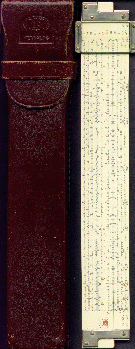
1956 700001 through about 709000
1957 800001 845800
1958 900001 922300
1959 000001 019700
1960 100001 125200
1961 200001 240700
1962 300001 338000
1963 400001 420000
1964 500001 523700
1965 600001 630514 * actual reported s/n
1966 700001 736200
1967 800001 840200
1968 900001 ?
Why did Hemmi start Versalog serial numbers with 700001 in 1956? In 1956 the Hemmi year code was 'G', the seventh letter of the alphabet.
August, 1958. The tiny (1 mm high) two-letter date code is moved from the top edge to the bottom edge, and is only stamped into the celluloid and not colored. It is sometimes quite faint, requiring magnification to find and read it.
Early 1960. The COS scale is changed from navy to green; labeling is moved from the top to the bottom edge; Cat No. is dropped, leaving only 1460. Our notation for this rule is type 1b; prior rules are type 1a.
Late 1961. Bamboo is dropped from the labeling, leaving only Hemmi Japan.
Late 1968. Serial numbers on the rules are discontinued.
Late 1968. Scales are rearranged and an A scale is added. Post called this slide rule the 'Versalog II', although this name appears only on packaging and manuals and is not imprinted on the rule. Several labeling changes accompany this addition.
About June, 1973. The last Post Versalog II is made. The first Teledyne-Post Versalog II (new model number 44CA-600) appeared a little before then, in June 1972. For a long time, the last T-P Versalog we knew of had the date code WH (August 1972), but a recently acquired Versalog 44CA-600 example has surfaced with the date code XF, indicating June 1973 production.
 Versalog Cases
Versalog Cases
Versalog cases were provided in three basic varieties:
- The familiar high quality cordovan color leather case (which has several variants). Versalogs sold in this case were listed as 1460L.
- The 'fabricoid' case, black, with black leather flap. Versalogs in this case were listed as 1460F and were a few dollars lower in price than 1460L.
- The molded gray plastic case, catalog number 1460M. This version carried a lower price than 1460L.
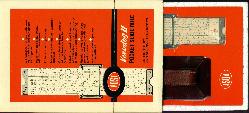
 Post 1461 Pocket Versalogs
Post 1461 Pocket Versalogs
 The 5-inch pocket Versalog 1461 was introduced about August 1957. The first models have exposed bamboo edges, which changed to celluloid covered edges in late 1962. The changes from navy COS scale to green COS scale and the addition of the A scale coincided with those changes in the Versalog 1460. About 100,000 model 1461 pocket Versalogs were made.
The 5-inch pocket Versalog 1461 was introduced about August 1957. The first models have exposed bamboo edges, which changed to celluloid covered edges in late 1962. The changes from navy COS scale to green COS scale and the addition of the A scale coincided with those changes in the Versalog 1460. About 100,000 model 1461 pocket Versalogs were made.
 Versalog Instruction Manuals
Versalog Instruction Manuals
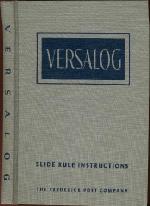
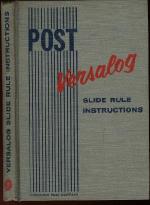
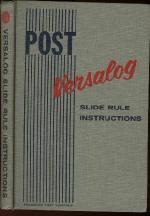
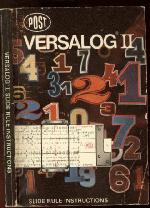
 High quality hardback Versalog manuals were published by Post in 1951, 1962 and 1963, with the latter two describing the change of the COS scale to green. The 1963 version mentions the 5-inch Versalog 1461 for the first time. Teledyne Post also published Versalog manuals in paperback for the Versalog II, with copyright dates of 1970 and 1971.
High quality hardback Versalog manuals were published by Post in 1951, 1962 and 1963, with the latter two describing the change of the COS scale to green. The 1963 version mentions the 5-inch Versalog 1461 for the first time. Teledyne Post also published Versalog manuals in paperback for the Versalog II, with copyright dates of 1970 and 1971.
 Letters in Post Catalog and Model Numbers
Letters in Post Catalog and Model Numbers
 'L' is the most common letter included in Post slide rule catalog numbers. L simply indicates a slide rule sold with a leather case. For example, in 1932 the Post 1448 slide rule cost $4.75 and the 1448L slide rule, with leather case, cost $5.50. This is one of the instances where the Post catalog number was different from the model number; both of these rules were model 1448.
'L' is the most common letter included in Post slide rule catalog numbers. L simply indicates a slide rule sold with a leather case. For example, in 1932 the Post 1448 slide rule cost $4.75 and the 1448L slide rule, with leather case, cost $5.50. This is one of the instances where the Post catalog number was different from the model number; both of these rules were model 1448.
 'F' was the suffix used in Post catalogs to indicate a downgrade to a black 'fabricoid' case with leather flip-top. 'M' indicated a molded plastic case. No Post slide rule actually bore the letters L, F, or M.
'F' was the suffix used in Post catalogs to indicate a downgrade to a black 'fabricoid' case with leather flip-top. 'M' indicated a molded plastic case. No Post slide rule actually bore the letters L, F, or M.
 When Hemmi added a K scale to some of its rules, it added the letter 'K' to its model designation; thus, the Hemmi 34RK is just a Hemmi 34R with a K scale added. Post followed Hemmi's lead in this matter; the Post 1444 is a relabeled Hemmi 34R and the Post 1444K is a relabeled Hemmi 34RK.
When Hemmi added a K scale to some of its rules, it added the letter 'K' to its model designation; thus, the Hemmi 34RK is just a Hemmi 34R with a K scale added. Post followed Hemmi's lead in this matter; the Post 1444 is a relabeled Hemmi 34R and the Post 1444K is a relabeled Hemmi 34RK.
 'W' is another letter carried over from Hemmi. The Post 1452W is a relabeled Hemmi 50W; these rules are about 6 mm wider than the older Post 1452 / Hemmi 50.
'W' is another letter carried over from Hemmi. The Post 1452W is a relabeled Hemmi 50W; these rules are about 6 mm wider than the older Post 1452 / Hemmi 50.
 'D' was used on several low quality rules made during World War II when Japanese Hemmi rules were unavailable. The 1446-D was made by Lawrence Engineering Service. (There are a few Post 1446s made by Lawrence at this time that do not bear the 'D' suffix.) The 1444D, 1447D and 1452D were made by Charvoz-Roos. Charvoz also made some World War II rules that did not carry a suffix: 1442, 1457 and 1462. All these slide rules were discontinued after the war.
'D' was used on several low quality rules made during World War II when Japanese Hemmi rules were unavailable. The 1446-D was made by Lawrence Engineering Service. (There are a few Post 1446s made by Lawrence at this time that do not bear the 'D' suffix.) The 1444D, 1447D and 1452D were made by Charvoz-Roos. Charvoz also made some World War II rules that did not carry a suffix: 1442, 1457 and 1462. All these slide rules were discontinued after the war.
 'P' generally denoted an all-plastic slide rule. The Post 1444P and 1452P were high quality all-plastic slide rules made by Charles Bruning Company during World War II. It appears that Post liked the 1444P so much that it continued to sell them with Hemmi cursors for a few years after the war. The Post 1445P and 1447P were post-war all-plastic rules manufactured by Hemmi.
'P' generally denoted an all-plastic slide rule. The Post 1444P and 1452P were high quality all-plastic slide rules made by Charles Bruning Company during World War II. It appears that Post liked the 1444P so much that it continued to sell them with Hemmi cursors for a few years after the war. The Post 1445P and 1447P were post-war all-plastic rules manufactured by Hemmi.
 After the war, Post returned to importing Hemmi slide rules from Japan, including the Hemmi model 159 slide rule. The Hemmi 159 scale arrangement had already been used during the war on the Post 1462 (manufactured by Charvoz-Roos), so the Post catalog number assigned to the Hemmi rule was 1462H. We know of no other H-suffix Post slide rules.
After the war, Post returned to importing Hemmi slide rules from Japan, including the Hemmi model 159 slide rule. The Hemmi 159 scale arrangement had already been used during the war on the Post 1462 (manufactured by Charvoz-Roos), so the Post catalog number assigned to the Hemmi rule was 1462H. We know of no other H-suffix Post slide rules.
 'T' indicated an 'extra thin' slide rule.
'T' indicated an 'extra thin' slide rule.
 Other Letters: In pre-Hemmi days Post often used the letters A, B, C, etc. in its catalogs to indicate related non-Post brand slide rules. For example, in the 1921 Post catalog, 1437, 1437A, 1437B, and 1437C indicated different models of Richardson slide rules. These were catalog numbers, not model numbers; we don't believe that these numbers actually appeared on the rules.
Other Letters: In pre-Hemmi days Post often used the letters A, B, C, etc. in its catalogs to indicate related non-Post brand slide rules. For example, in the 1921 Post catalog, 1437, 1437A, 1437B, and 1437C indicated different models of Richardson slide rules. These were catalog numbers, not model numbers; we don't believe that these numbers actually appeared on the rules.
 Teledyne continued the old numbering system for a few years after it took over Post in 1970 but, about 1972, Teledyne Post introduced the '44' numbering system. In this system, the last place in the catalog number indicated various combinations of case, instructions, and display boxes. For example, the Teledyne Post model number for the 5-inch pocket Versalog was 44DA-610, but, when sold with an instruction manual, the catalog number was 44DA-61L; and when sold without the instruction manual, the catalog number was 44DA-61O (letter 'O').
Teledyne continued the old numbering system for a few years after it took over Post in 1970 but, about 1972, Teledyne Post introduced the '44' numbering system. In this system, the last place in the catalog number indicated various combinations of case, instructions, and display boxes. For example, the Teledyne Post model number for the 5-inch pocket Versalog was 44DA-610, but, when sold with an instruction manual, the catalog number was 44DA-61L; and when sold without the instruction manual, the catalog number was 44DA-61O (letter 'O').
 The Table of Post Slide Rules
The Table of Post Slide Rules
 We have listed, in the accompanying table, every slide rule sold by Post or Teledyne Post for which we can establish a catalog number. (Listing all slide rules ever sold by Post is an impossible goal; Post sold many special-purpose rules that were not listed in its catalogs. To quote the 1921 Frederick Post Catalog: 'We also make a number of other special slide rules, which we do not list in our catalogue, but shall be glad to send particulars upon request.')
We have listed, in the accompanying table, every slide rule sold by Post or Teledyne Post for which we can establish a catalog number. (Listing all slide rules ever sold by Post is an impossible goal; Post sold many special-purpose rules that were not listed in its catalogs. To quote the 1921 Frederick Post Catalog: 'We also make a number of other special slide rules, which we do not list in our catalogue, but shall be glad to send particulars upon request.')
 Many Post catalog numbers were duplicated over the years, with 1444 being the most popular. There are 16 different rules bearing the number 1444, including suffixes, from 1910 to 1971. Some are variants within the 1444 model number series, and some are completely different rules. The 1452 series also has several variants.
Many Post catalog numbers were duplicated over the years, with 1444 being the most popular. There are 16 different rules bearing the number 1444, including suffixes, from 1910 to 1971. Some are variants within the 1444 model number series, and some are completely different rules. The 1452 series also has several variants.
 The 1460 Versalog itself shares its catalog number with two other, totally different, rules, the 1460 Ritow High School Mannheim 10-inch rule from the 1925 catalog, and the 1460 Engineer's Universal Duplex 20-inch rule from the 1936 catalog.
The 1460 Versalog itself shares its catalog number with two other, totally different, rules, the 1460 Ritow High School Mannheim 10-inch rule from the 1925 catalog, and the 1460 Engineer's Universal Duplex 20-inch rule from the 1936 catalog.
 The 10-inch model 1461, listed in the 1936 catalog, has likewise caused considerable confusion with the popular 5-inch pocket Versalog model 1461.
The 10-inch model 1461, listed in the 1936 catalog, has likewise caused considerable confusion with the popular 5-inch pocket Versalog model 1461.
 The table gives the catalog number and characteristics of each rule. Important variants of each slide rule are listed separately. We considered the following factors to be important enough to warrant listing slide rules as separate variations:
The table gives the catalog number and characteristics of each rule. Important variants of each slide rule are listed separately. We considered the following factors to be important enough to warrant listing slide rules as separate variations:
- Different manufacturers,
- Different arrangements of scales,
- Different model names or numbers on the rules.
The following factors do not warrant separate listing:
- Presence or absence of scale labels,
- Different cursors (Hemmi Mannheim rules generally had reversed 'C' cursors through 1936 and conventional cursors from 1937 on. Some of the cheaper rules acquired plastic cursors in the 1960s.),
- Different locations of name, model number or other information on the slide rules,
- Different cases, instructions, or any other characteristic not actually on the slide rules.
 According to these rules the Post 1460 Versalog slide rule with green COS scale (1b) does not warrant a separate listing from the 1460 Versalog with navy COS scale (1a). Nevertheless we have listed these as separate variants because the Versalog is so popular among collectors. (And, besides, we can violate our own rules if we want.)
According to these rules the Post 1460 Versalog slide rule with green COS scale (1b) does not warrant a separate listing from the 1460 Versalog with navy COS scale (1a). Nevertheless we have listed these as separate variants because the Versalog is so popular among collectors. (And, besides, we can violate our own rules if we want.)
 Acknowledgment and Disclaimer
Acknowledgment and Disclaimer
 We owe particular thanks to the many slide rule collectors who shared information with us. Among these are Ed Chamberlain, David Crate, Don DiGalbo, Jay Francis, John Irving, Craig Kielhofer, Mike Larson, Bob Otnes, Dick Rose, Warren Salomon, Skip Solberg and John Thomas.
We owe particular thanks to the many slide rule collectors who shared information with us. Among these are Ed Chamberlain, David Crate, Don DiGalbo, Jay Francis, John Irving, Craig Kielhofer, Mike Larson, Bob Otnes, Dick Rose, Warren Salomon, Skip Solberg and John Thomas.
 This article is based on our own collections of Post slide rules, Frederick Post catalogs and price lists, various instruction manuals and other documents, and information from other collectors. We believe our statements to be accurate, but much of our knowledge rests upon weak or ambiguous evidence so there are surely quite a few errors. We shall be indebted to anyone who can supply corrections or new information. Please address correspondence to Ted Hume, P. O. Box 63021, San Angelo, TX 76906 or to Paul Ross, RR. 1, Box 391, Fair Grove, MO 65648.
This article is based on our own collections of Post slide rules, Frederick Post catalogs and price lists, various instruction manuals and other documents, and information from other collectors. We believe our statements to be accurate, but much of our knowledge rests upon weak or ambiguous evidence so there are surely quite a few errors. We shall be indebted to anyone who can supply corrections or new information. Please address correspondence to Ted Hume, P. O. Box 63021, San Angelo, TX 76906 or to Paul Ross, RR. 1, Box 391, Fair Grove, MO 65648.
 The following general information is extracted from POST Literature, this applies to every Hemmi manufactured bamboo core POST rule
The following general information is extracted from POST Literature, this applies to every Hemmi manufactured bamboo core POST rule
 LAMINATED BAMBOO CONSTRUCTION
LAMINATED BAMBOO CONSTRUCTION
To insure accuracy, your POST slide rule is constructed of laminated bamboo. Bamboo is tough, resists contraction and expansion under varying climatic conditions. bamboo has natural oils, imperceptible to the touch, which constantly lubricate the bearing surfaces. You'll experience a smoothness of action not found in rules produced from other materials. Your POST slide rule will actually operate easier the longer you use it!
 ENGINE DIVIDED SCALES
ENGINE DIVIDED SCALES
All graduations are "engine-divided." (engraved). Every marking is cut into the snow-white plasic face with a precisely controlled knife-edge. Engine-divided scales are easy to read, unfailingly accurate, and last the lifetime of the rule.
 CAUTION!
DO NOT use powder, or other supposed lubricants on your POST slide rule, since they will impair the natural lubricating qualities of the bamboo material.
CAUTION!
DO NOT use powder, or other supposed lubricants on your POST slide rule, since they will impair the natural lubricating qualities of the bamboo material.
 It's easy to care for your POST slide rule. Following these simple steps will insure long life and easy operation of your POST slide rule.
It's easy to care for your POST slide rule. Following these simple steps will insure long life and easy operation of your POST slide rule.
1. Keep hands clean when operating the rule, return rule to its case when not in use.
2. To clean scales, wipe with a damp, soft cloth. If plastic faces become extremely soiled, they may be cleaned with mild soap and a damp sponge.
3. DO NOT use solvents or detergents to clean POST slide rules, as this may affect markings and hinder easy operation.
|
|

E-Mail Us ! |
 |
You are visitor number
  . .
Site Design & contents copyright 1999, 2003, 2004, 2007, 2008, 2010
by Walter Shawlee 2, Ted Hume & Paul Ross. |




